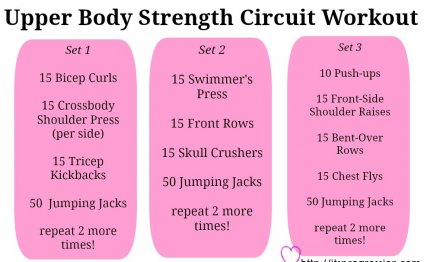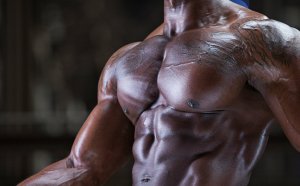
Upper body Workout Routines
Alright, time to give away some muscle building SeCReTZ… for free.
I’ve previously covered the basics of putting together a generic upper body workout that can suit a variety of training goals. Today however I want to look at one specific goal and walk you through the template I personally like to use when designing a program for it.
What goal is that, you ask? Muscle hypertrophy… aka muscle growth.
Please note that there are a hundred different ways this can be done effectively, so the following is certainly not the only way to do it. It is however the way I prefer to do it, and the way that I’ve found works best. It’s by far my favorite “upper body day” template.
Here we go…
Step 0: Individualization
Normally, the first step of ANY workout program design is individualization. This of course means taking the individual needs, goals, preferences, training/injury history, etc. of the specific person the routine is being designed for, and going forward with all of that in mind.
Since we don’t have a specific person in this case (it’s you, but um… I don’t actually know anything about you), we’re going to be skipping this step. Instead, we’ll just assume it’s some random generic person whose primary goal is to build muscle as quickly and effectively as possible.
With me so far? Awesome.
Step 1: Exercise Selection, Rep Ranges And Rest Periods
- 2 chest exercises.
One will typically be a flat or decline movement, and the other will typically be an incline movement (15-30 degree incline). The exercises themselves will either both be compound pressing exercises (like barbell bench press and incline dumbbell press), or one compound press (like any barbell, dumbbell or machine press) and one isolation type movement (like dumbbell or cable flyes, pec deck, etc.). Whatever they end up being, the first chest exercise in the workout will be done heavier and in a lower rep range (typically 5-8) with longer rest periods (2-4 minutes), and the other will be a little lighter and in a slightly higher rep range (typically 8-12, though sometimes as high as 15) with shorter rest periods (1-2 minutes). Why? Because the two primary training factors influencing muscle growth are tension and fatigue, and this gives us a nice combination of both. - 2 back exercises.
One will be a horizontal pulling movement (like bent over rows, seated cable rows, chest supported rows, etc.), and the other will be a vertical pulling movement (like pull-ups, chin-ups or lat pull-downs). Just like before with chest, the first back exercise in this upper body workout will be done heavier, lower in reps, longer in rest periods… while the other will be a little lighter, higher in reps, shorter in rest periods. - 1 shoulder exercise.
The shoulder exercise will almost ALWAYS be either an overhead press (like a seated or standing barbell or dumbbell shoulder press), or some type of lateral raise (dumbbell, cable, whatever). Why not front raises? Because it’s the most unnecessary exercise on the planet for most people. Now, whether I choose an overhead press or lateral raise is mostly dependent on what the chest exercise selection is. If both chest exercises are compound pressing movements (especially if one of them is an incline press), the shoulder exercise will typically be lateral raises. But if one of the two chest exercises was an isolation movement, the shoulder exercise usually becomes an overhead press. And if it’s an overhead press, I’ll usually go with a low-moderate rep range (5-10) and moderate-long rest (1:30-3 minutes). If it’s lateral raises, it will be a higher rep range (10-15) and shorter rest (1-2 minutes). - 1 biceps exercise.
This will be some kind of isolation curling movement (dumbbell curls, etc.) done in a higher rep range (10-15) with shorter rest periods (1-2 minutes). - 1 triceps exercise.
If there are already 2 (or more) compound pressing exercises in this workout (which is usually how it should be), the triceps exercise will be an isolation movement (like cable pushdowns, skull crushers, etc.) in a higher rep range/shorter rest periods (10-15, 1-2 minutes). If however there is only one pressing exercise in this workout and the rest of the chest/shoulder work is isolation stuff (e.g. incline barbell press, flat dumbbell flyes and lateral raises), then this triceps exercise can optionally become a compound movement (like dips or close grip bench press). - Other
Sometimes stuff like shrugs or rear delt work can be included, too. But, that’s mostly just optional accessory stuff that is dependent on the individual needs/preferences of the person, so I tend to leave it off by default. The stuff above this is what matters most in an upper body workout designed for building muscle.
Step 2: Volume
From there it’s time to prescribe how many sets and reps will be done for each exercise. I like to start by first figuring out what the total volume for each muscle group should be in the workout, and then divide that volume up over whatever number of exercises each muscle group will have.
This is one of those areas that is highly dependent on the individualization stuff we skipped over before, because volume tolerance can vary greatly from person to person. But, assuming once again that we’re talking about some average generic person, here’s what I’ve found to be optimal for most people.
- Chest volume: Between 30-60 total reps in this workout. Since there are 2 chest exercises, this amount will be divided up among those two exercises.
- Back volume: Between 30-60 total reps in this workout. Since there are 2 back exercises, this amount will be divided up among those two exercises.
- Shoulder volume: Between 20-40* total reps in this workout. Since there is 1 shoulder exercise, it will all come from this one exercise. (*Note: I actually find shoulder volume to be the trickiest to give generic recommendations for, because it has a lot to do with what was done for chest. For example, if you’ve already done flat and incline pressing, the anterior deltoid doesn’t need much more volume (if any), but the lateral deltoid does. But, 20-40 reps is usually about where it should be.)
- Biceps volume: Between 20-30 total reps in this workout. Since there is 1 biceps exercise, it will all come from this one exercise.
- Triceps volume: Between 20-30 total reps in this workout. Since there is 1 triceps exercise, it will all come from this one exercise.
INTERESTING VIDEO



Share this Post
Related posts
Full body workout routines
Full body training is very effective at bringing up weak body parts because you can hit them first three times a week. While…
Read MoreDumbbell upper body Workouts
Chest Bench Press. Lie face up on an exercise bench, knees bent and feet flat on the floor. Hold the dumbbells on each side…
Read More









